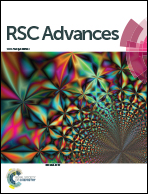Development of composite anion-exchange membranes using poly(vinyl alcohol) and silica precursor for pervaporation separation of water–isopropanol mixtures
Abstract
Composite anion-exchange membranes were prepared using sol–gel techniques with poly(vinyl alcohol) (PVA) and anion-exchange silica precursor (AESP). Ammonium functionality was created on the AESP through a ring opening reaction between 2-(3-aminoethylamino)propyltrimethoxysilane and glycidyltrimethylammonium chloride under mild heating conditions. The resulting membranes were subjected to physico-chemical investigations using various techniques. The pervaporation performance of the membranes was systematically investigated based on the effects of feed composition and the mass% of AESP. Among the membranes studied, the membranes containing 4 mass% of AESP exhibited the highest separation factor of 2991 with a flux of 10.76 × 10−2 kg m−2 h−1 at 30 °C for 10 mass% of water in the feed. The trade-off phenomenon which exists between the flux and the separation factors was overcome by the incorporation of AESP in PVA matrix. We find that the overlap between the total flux and flux of water, suggests that these membranes could be used effectively to break the azeotropic point of water–isopropanol mixtures. From the temperature dependent diffusion and permeation values, the Arrhenius activation parameters were estimated. The Ep and ED values ranged between 18.36 and 7.94, and 18.68 and 8.09 kJ mol−1, respectively. The negative heat of sorption (ΔHs) values was obtained for all the membranes, indicating that Langmuir's mode of sorption is predominant in the transport process.


 Please wait while we load your content...
Please wait while we load your content...